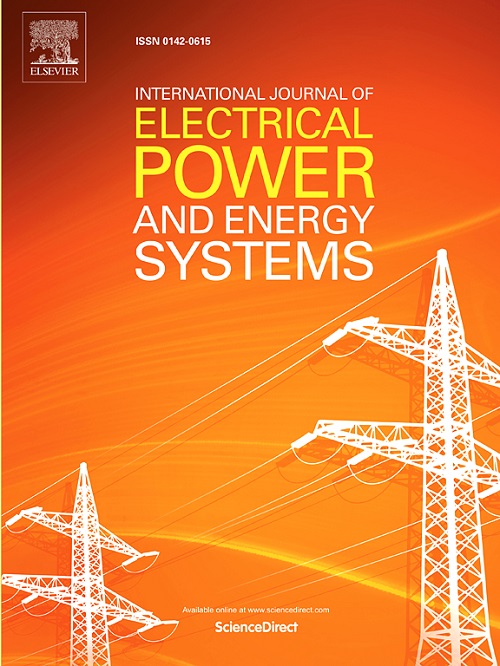Source-network-load-storage collaborated two-stage power dispatch of active distribution network with conditional value-at-risk
IF 5
2区 工程技术
Q1 ENGINEERING, ELECTRICAL & ELECTRONIC
International Journal of Electrical Power & Energy Systems
Pub Date : 2025-09-17
DOI:10.1016/j.ijepes.2025.111120
引用次数: 0
Abstract
The high penetration of distributed wind turbines (WT) and photovoltaics (PV) brings temporal volatility and uncertainty to their output, posing significant challenges to the optimal scheduling of distribution networks. By reasonably quantifying risks and coordinating the scheduling of generation, grid, load, and storage resources, risk losses can be minimized and economical operation of active distribution networks (ADN) can be achieved. Aiming at the difficulties in accurately quantifying operational risks under high renewable energy penetration, the challenges of coordinated optimization scheduling for multiple types of source-grid-load-storage devices, high system operation risks, and poor economic performance, this paper proposes a CVaR-based method to quantify operational losses in low-probability high-risk scenarios for ADN, and constructs a two-stage risk scheduling model with day-ahead and intra-day coordination of source-grid-load-storage resources. In the day-ahead scheduling stage, deterministic forecasts of wind and PV are considered, with the objective of optimizing slower-responding discrete devices to minimize the daily comprehensive operational cost of the ADN. Based on the day-ahead decisions for discrete devices, the intra-day scheduling stage introduces typical wind and PV scenarios with high-risk loss values, forming an optimal scheduling model that takes into account both multi-scenario daily comprehensive operational costs and high-risk scenario loss values. This enables optimal coordination and scheduling of fast-responding continuous devices, promoting the collaborative and optimal operation of source, grid, load, and storage equipment. Case studies show that, compared with other scheduling methods, the proposed two-stage risk scheduling model can improve the economic performance of grid operation while effectively reducing the high operating costs and violation risks caused by wind and PV fluctuations.
带条件风险值的有源配电网源-网-蓄协同两级电力调度
分布式风力发电和光伏发电的高渗透率带来了其输出的时间波动性和不确定性,对配电网的优化调度提出了重大挑战。通过对风险进行合理量化,协调发电、电网、负荷和存储资源的调度,可以最大限度地降低风险损失,实现主动配电网的经济运行。针对可再生能源高渗透率下运行风险难以准确量化、多类型源网-负荷-存储设备协同优化调度面临的挑战、系统运行风险高、经济效益不佳等问题,提出了一种基于cvar的ADN低概率高风险场景运行损失量化方法。并构建了源-网-负荷-存储资源日前和日内协调的两阶段风险调度模型。在日前调度阶段,考虑风电和光伏的确定性预测,以优化响应较慢的离散设备,使ADN的日综合运行成本最小。日内调度阶段以离散设备日前决策为基础,引入具有高风险损失值的典型风电和光伏场景,形成兼顾多场景日综合运行成本和高风险场景损失值的最优调度模型。这可以实现快速响应的连续设备的最佳协调和调度,促进源、电网、负载和存储设备的协作和最佳运行。实例研究表明,与其他调度方法相比,所提出的两阶段风险调度模型可以提高电网运行的经济效益,同时有效降低风电和光伏波动带来的高运行成本和违规风险。
本文章由计算机程序翻译,如有差异,请以英文原文为准。
求助全文
约1分钟内获得全文
求助全文
来源期刊
CiteScore
12.10
自引率
17.30%
发文量
1022
审稿时长
51 days
期刊介绍:
The journal covers theoretical developments in electrical power and energy systems and their applications. The coverage embraces: generation and network planning; reliability; long and short term operation; expert systems; neural networks; object oriented systems; system control centres; database and information systems; stock and parameter estimation; system security and adequacy; network theory, modelling and computation; small and large system dynamics; dynamic model identification; on-line control including load and switching control; protection; distribution systems; energy economics; impact of non-conventional systems; and man-machine interfaces.
As well as original research papers, the journal publishes short contributions, book reviews and conference reports. All papers are peer-reviewed by at least two referees.

 求助内容:
求助内容: 应助结果提醒方式:
应助结果提醒方式:


